2023 Kawasaki KLX230 S Review - First Ride

Reducing the seat height without lowering expectations
Entry level dual-sport has for a very long time existed in the void between categories, particularly when you consider folks who are shorter in the inseam. We all need to start somewhere, but for most who did not grow up riding, or maybe started exclusively on street motorcycles, the reality is that the entry-level engine size is often combined with the inability to comfortably touch the ground at a stop. That’s enough to deter all but the most stubborn of vertically challenged riders. Kawasaki is hoping to change this with the 2023 Kawasaki KLX230 S.
2023 Kawasaki KLX230 S
Editor Score: 89%
| Engine | 17/20 | Suspension | 14/15 | Transmission | 9/10 |
| Brakes | 8/10 | Instruments | 4/5 | Ergonomics | 9/10 |
| Appearance | 10/10 | Desirability | 9/10 | Value | 9/10 |
+ Highs
- Lower seat height is perfect for those with a shorter inseam.
- ABS is only $300 more and is calibrated for dual-sport use.
- Battle Grey paint scheme is a fantastic addition to color options
– Sighs
- Aftermarket protective options may need some time to catch up
- Digital dash could have more data available, like a gear indicator or RPM
- We’re having a hard time finding anything else to complain about
Typically, entry-level dual-sport motorcycles with lower seats are forced into compromises to achieve the desired lowness, such as using smaller wheels, underpowered engines, and very basic suspension. While this is helpful initially, riders often grow out of the bike’s capabilities very quickly, and the bike starts holding them back from the skills they could have been learning on something more suited to a wider variety of terrain or the ability to achieve higher speeds.
Enter the Kawasaki KLX230 S. By equipping it with full size wheels (21 in the front 18 in the rear), the same KLX230 motor as the standard height version, and a full 2-inch lower seat height made possible by adjustments to the suspension height and chassis, Kawasaki is certainly making a play to fill that void. While the ground clearance is a bit less than the standard model – about eight inches vs 10 inches – one could argue that you don’t see enduro style obstacles on easily accessible trails. Beginner and even some intermediate riders don’t typically utilize the bike in such a way to require the extra suspension travel anyways.
While the standard KLX230 comes without ABS, it’s a $300 option on the KLX230 S that allows the rear ABS to be easily disabled with the hold of a button on the left side control housing.There is a non-ABS 230 S model offered, though limited only to the flagship Kawasaki green and white livery. Although the ABS does reset when the bike is cycled off, its easily accessible bright red button makes for a quick reminder to adjust: simply stop the bike and hold the button for a few seconds.
Is this the answer to the intro-dual-sport question? For many new riders, absolutely. We were able to test this bike on a variety of terrain, from disintegrated asphalt on a twisty canyon road to a typical rocky ridgeline trail, fresh slick mud, and even loose gravel. I opted not to switch off the ABS for any of the riding portion, eager to see how the bike would respond to my still-slightly-learning reaction times. The only time I felt the ABS engage on the rear was when I was intentionally slamming the rear brake on roadside gravel. On the trail, I didn’t notice it hindering me in any way, and after learning that Kawasaki had intentionally calibrated the ABS sensors for dual-sport use, it was clear that for the beginner-to-average rider, it would be helpful in most common riding situations.
While I (happily) didn’t get a chance to pick this bike up off the ground, I was pretty impressed with how balanced it felt. Maneuvering it to turn around on a tight trail was easy because the bike didn’t feel too top heavy or cumbersome. The low 32.7-inch seat height meant that stopping or dismounting on uneven terrain wasn’t as perilous as it could have been. Instead, it instilled confidence in my ability to pause as another rider cleared a rocky section and made it easy to hop off the bike to check out line options. For my 28-inch inseam and short arm length, I felt right at home on this bike. I’ve spent considerable time on a similar dual-sport at home – my 2021 Yamaha TW200. The difference between these was evident in a few ways, namely the engine power and the handling. While I am accustomed to the TW’s fat tires soaking up much of the terrain on trails, the suspension on the KLX made quick work of any line I took, whether intentional or not.
The suspension on the 230 S is unique to this model specifically: in order to reduce the seat height without compromising the geometry and handling of the bike, Kawasaki developed a progressive spring for the rear, “made specifically [with] lighter and smaller riders in mind.” While the suspension itself is shortened, in both the front and rear, the capabilities of the spring itself are refined. For those who are new to off-road (like myself), discussion about tweaking compression or rebound often sounds like another language. To put it into words that are a bit more digestible for suspension-illiterate riders like myself: the rear spring is a two part spring with the majority of the spring reacting to the typical weight and speed needed for average off-road riding, the second more tightly coiled part of the spring comes into play when you ask a bit more of the suspension. At a taller obstacle or drop off or maybe hitting a rocky section at a higher speed, the tighter coil provides more resistance and prevents the suspension from completely bottoming out.
The 233cc four-stroke engine delivers steady power from the get-go. First gear lends enough low end oomph to tiptoe over rocks and through ruts without losing momentum, and a hesitant rider won’t be startled by clicking up into higher gears when the trail smooths out. Hopping on the highway for short sprints isn’t too painful either. Sailing along at a steady 65-70, the bike felt planted and stable with room in the throttle to move in a pinch. The two-gallon tank gives plenty of range, averaging a claimed 85-90 miles with a mix of on and off-road use.
The Battle Grey colorway is an attractive choice, standing out in the sea of candy-colored options. Notable upgrades for the 2023 KLX 230 S line are the streamlined LED headlight assembly and housing and lockable toolbox located in the left side cover. For those who like to keep tools handy and your backpack free for snacks, this is a compartment that should come standard on all dual-sports.
Does this bike do the right things for newer riders? Absolutely. When a motorcycle is designed with a particular rider in mind, it really does stand out in its category. The most important thing to a newer rider is how comfortable they feel with the basics. Sometimes, we forget that beginners spend more time starting and stopping, with pausing to assess the trail being part of the learning experience. The lower seat height on the KLX 230 S instills immediate confidence and is sure to make a world of difference for those who have spent more trail time panicking about finding an even spot or handy rock to balance on.
While some may argue that struggling with bike height is part of the learning curve of dirt riding, I’d love to cut it out completely. My own off-road learning experience was temporarily halted because I couldn’t find a bike I felt comfortable riding on my own, and it was only through chasing down a smaller bike that I was able to build some confidence and slowly work my way to some real skills. The 2023 Kawasaki KLX230 S dual-sport was purpose built with smaller riders in mind, without cutting out the important parts of its KLX lineage for a MSRP of $4,999 ($5,299 ABS).
In Gear

Helmet: Bell Moto-9 Mips Helmet
- Goggles: 100 Percent Strata 2 Goggles
- Jacket: Rev’It! Horizon 2 Women’s Jacket
- Pants: Atwyld Shift MX Pant (Unavailable)
- Gloves: Bilt Tempest Waterproof Gloves
- Boots: Alpinestars Tech 7
Backpack: Camelbak 3L Hydration Pack (Discontinued)
2023 Kawasaki KLX230 S Specifications | |
|---|---|
| Engine Type | 4-stroke single, SOHC, air-cooled |
| Bore x Stroke | 67.0 x 66.0mm |
| Displacement | 233cc |
| Compression Ratio | 9.4:1 |
| Fuel System | DFI® with 32mm Keihin throttle body |
| Ignition | TCBI Electronic Advance |
| Clutch | wet multi-disc manual clutch |
| Transmission | 6-speed |
| Final Drive | Chain |
| Frame | High-tensile steel, box-section perimeter |
| Front Suspension | 37mm telescopic fork/6.2 in. of travel |
| Rear Suspension | Uni-Trak® linkage system and single shock with adjustable spring preload/6.6 in. of travel |
| Front Brake | Single 265mm petal disc with a dual-piston caliper, ABS |
| Rear Brake | Single 220mm petal disc with single-piston caliper, ABS |
| Front Tire | 2.75 x 21 |
| Rear Tire | .10 x 18 |
| Rake | 27.5° |
| Trail | 4.6 in. |
| Wheelbase | 53.5 in. |
| Ground Clearance | 8.3 in. |
| Curb Weight | 297.7 lb. / 299.9 lb. CA model (claimed) |
| Seat Height | 32.7 in. |
| Fuel Capacity | 2.0 gallons |
We are committed to finding, researching, and recommending the best products. We earn commissions from purchases you make using the retail links in our product reviews. Learn more about how this works.
Become a Motorcycle.com insider. Get the latest motorcycle news first by subscribing to our newsletter here.

Cait is a motorcycle enthusiast first and foremost, often spending weeks at a time crisscrossing the country on her Moto Guzzi V7. She got her start in the industry running a women’s moto gear market that travelled the country, and has been able to see the women’s moto community grow from the inside out over the last 10 years. She is typically found on pavement but has been eagerly diving outside her riding comfort zone for the sake of a good story, previously riding her TW200 through two Biltwell 100 races and one very well intentioned LAB2V. While not glued to her motorcycle, Cait lives a secret life as a hairdresser and quilter.
More by Cait Maher




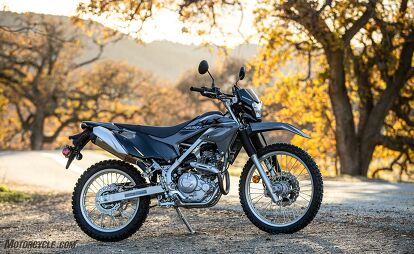















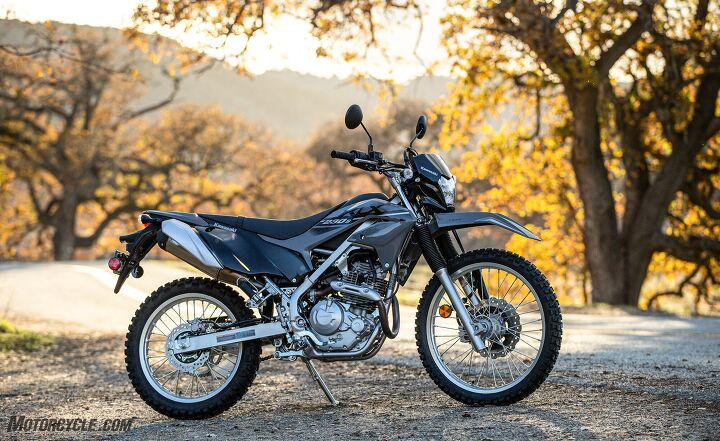


































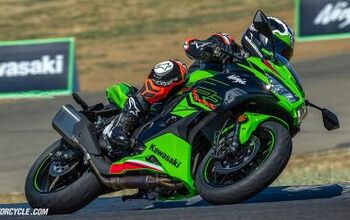


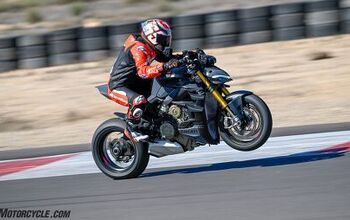
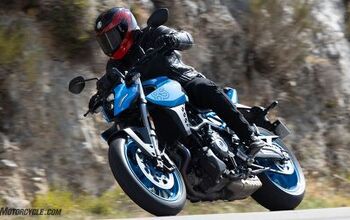







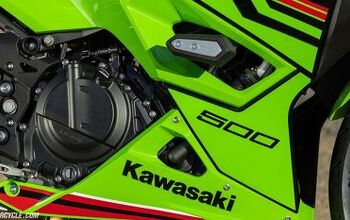


Comments
Join the conversation
Under powered, overweight! Having a ball with this bike in Western North Carolina. https://uploads.disquscdn.c...
Sorry, but your description of the progressive suspension spring is just the opposite of how they react to loading. The shorter, more tightly wound section handles the quick little impacts (trail junk), while the main section of the spring handles the jumps and G-outs. This is because the greater the helix angle, the more the force needed to deflect the suspension a given distance, and vice-versa. To demonstrate this, imagine increasing the helix angle until the spring wire is straight. Now you have a rigid strut, and you can guess how that would ride. A coil spring is nothing more than a torsion bar wound into a helix and behaves accordingly. A coil spring is easier to package than a torsion bar whose length is equal to the wire contained in a coil of the same wire diameter, material, and heat treatment.